Syria aid convoy attack: What we know
- Published
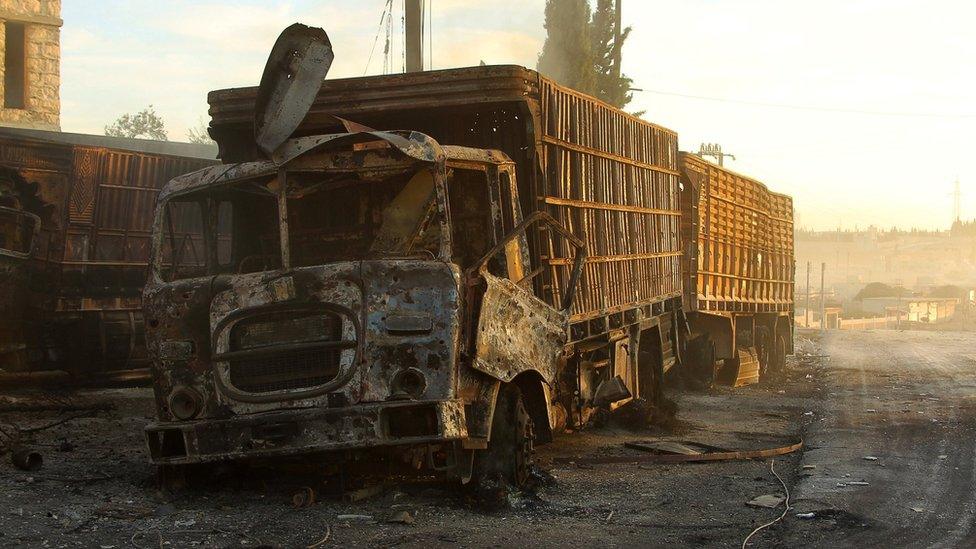
The UN called the attack on the convoy "sickening, savage and apparently deliberate"
An attack on a Syrian Arab Red Crescent (SARC) warehouse and a United Nations aid convoy in a rebel-held part of northern Syria on 19 September killed at least 18 civilians, including one aid worker.
The United States, which backs the rebels, believes Russian or Syrian government warplanes bombed the convoy.
But Russia, a key ally of President Bashar al-Assad, has rejected the accusation and said a US drone was flying overhead at the time of the attack.

What happened?
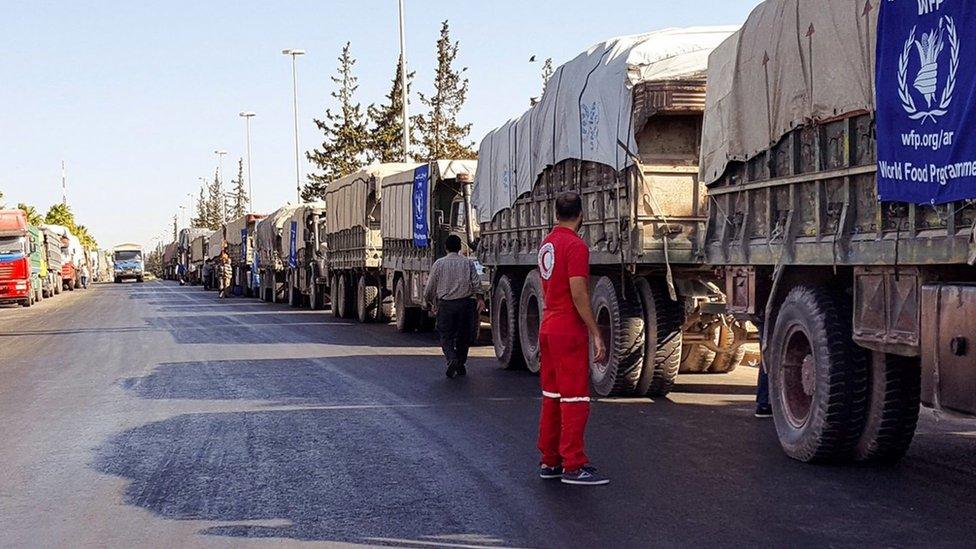
The Syrian Arab Red Crescent posted photos of the convoy before it set off for Urum al-Kubra
The SARC said, external the convoy consisted of 31 lorries loaded with non-food items, clothes and paediatric nutrients, supported by the World Food Programme, UN Refugee Agency (UNHCR) and UN Children's Fund (Unicef), and the International Organisation for Migration.
On the afternoon of 19 September, after co-ordinating with all parties on the ground, the convoy reached a SARC warehouse in Urum al-Kubra, a rebel-held town about 12km (8 miles) west of the divided second city of Aleppo, from where the aid was to be distributed to some 78,000 civilians, the SARC added.
At around 19:10 (16:10 GMT), as they were being unloaded, the attack on the lorries began, witnesses said. It was to last more than three hours.

Ammar al-Salmo, a volunteer search-and-rescue worker from the Syria Civil Defence, was in the area at the time and told, external Human Rights Watch: "We heard helicopters in the air just before the attack.
"The fires and strikes were so bad that we weren't able to even start a response to save people until three in the morning. That's when we started to pull out the deceased from under the rubble," he added.
"It is known to everyone in Urum al-Kubra and the area that this is a Red Crescent warehouse and there are no military bases around it."
A member of the Syria Civil Defence, also known as the White Helmets, describes the aftermath of the attack on an aid convoy in Urum al-Kubra
Photos and videos of the aftermath of the attack showed destroyed buildings and charred lorries, and damaged boxes of food and other supplies bearing the logos of the Red Cross, Red Crescent and UN agencies.
The following day, the SARC confirmed, external the deaths of around 20 civilians and the director of its Urum al-Kubra sub-branch, Omar Barakat. The UN subsequently gave, external a lower death toll of 18.
Of the 31 aid lorries, 18 were totally destroyed. The warehouse and an adjoining clinic operated by the SARC were also damaged.

Who is to blame?
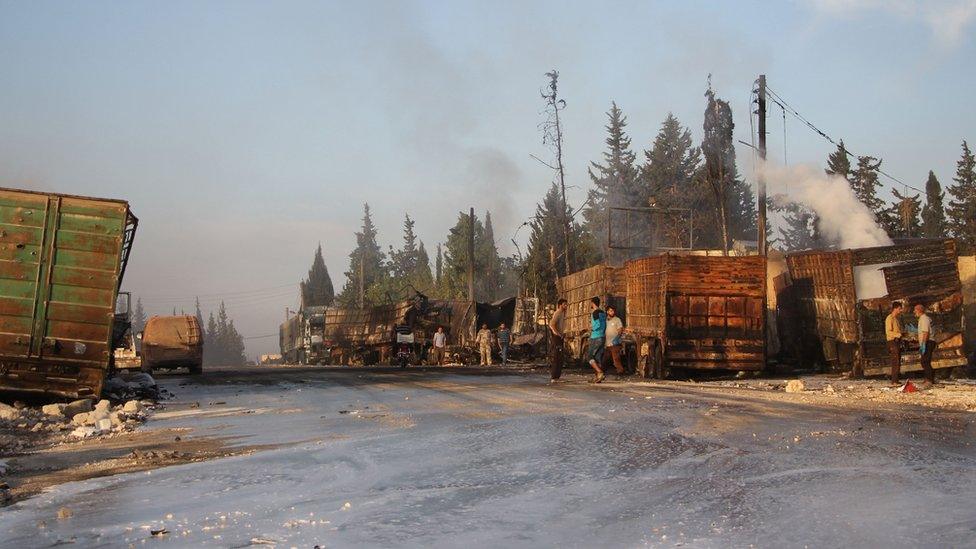
Russia said the damage to the convoy appeared to be caused by its cargo catching fire
The UN has said it is not yet in a position to determine how the convoy was attacked, and Secretary-General Ban Ki-moon has decided to establish an internal board of inquiry to investigate.
But the US, which backs the rebels, has said its information clearly indicates it was an air strike.
On 22 September, the chairman of the US military's Joint Chiefs of Staff, Gen Joseph Dunford, told, external a Senate committee that two Russian warplanes - reportedly Su-24 ground attack aircraft - had been in that area at the time of the attack, along with some "some other aircraft" belonging to the Syrian government.
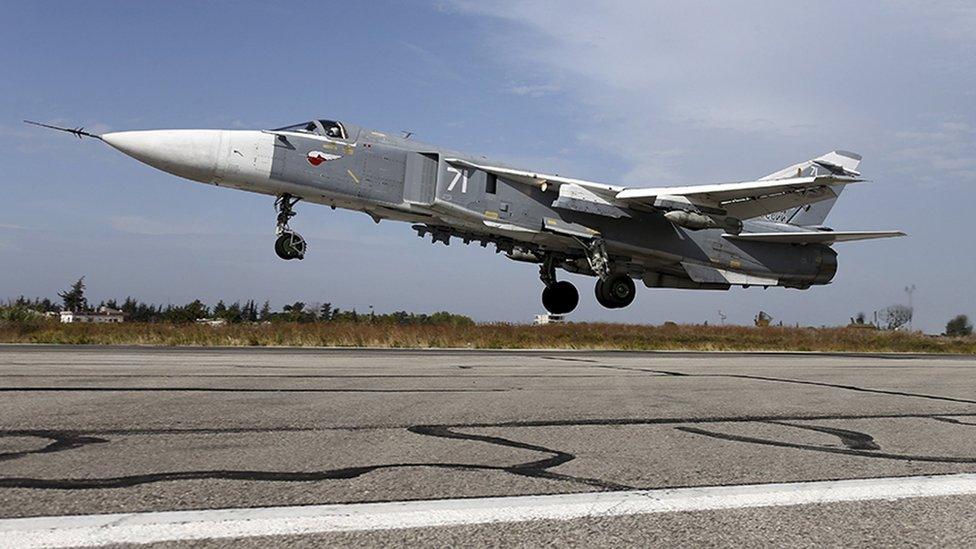
US officials said two Russian Su-24 were flying over Urum al-Kubra at the time of the attack
"There's no doubt in my mind that the Russians are responsible. I just don't know whose aircraft actually dropped the bomb," he said, calling the incident "an unacceptable atrocity".
The allegations have been vigorously denied by Russia. It has suggested they are an attempt to "distract attention" from an air strike by the US-led coalition against so-called Islamic State in the eastern city of Deir al-Zour on 13 September, which killed dozens of Syrian troops.
However, Moscow's story seems to have gone through several changes, says the BBC's Paul Adams.
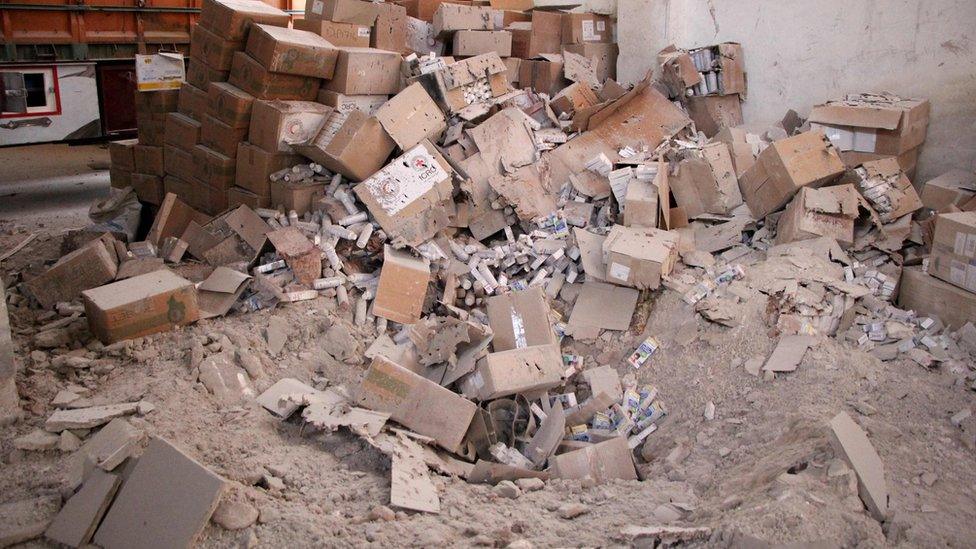
Pictures appear to show at least one crater, contradicting Russia's assertion that there are none
On 20 September, defence ministry spokesman Maj-Gen Igor Konashenkov said it had studied videos of the aftermath and "did not find any evidence that the convoy had been struck by ordnance".
"There are no craters and the exterior of the vehicles do not have the kind of damage consistent with blasts caused by bombs dropped from the air," he explained.
That seemed to contradict many of the images broadcast afterwards, our correspondent says.
Russia's defence ministry says its drone footage shows a pick-up truck towing a large-calibre mortar belonging to militants accompanying the convoy
The Russian defence ministry later released surveillance footage, external filmed by a drone, which it said showed the stationary aid convoy being passed by a pick-up truck towing a heavy mortar.
But the Interpreter magazine reported, external that the video was filmed in the Aleppo suburb of Khan al-Asal, external, some 6.5km (4 miles) east of Urum al-Kubra.
It also pointed to screengrabs, external of other drone footage reportedly streamed online by Russia on the day of the attack that appears to show the convoy being unloaded. The timestamp says 18:41.

Russia said a US Predator drone was flying over the site of the attack for about 30 minutes
On 21 September, Gen Konashenkov said a US Predator drone, armed with air-to-ground missiles, was flying above Urum al-Kubra at the time of the attack - an allegation the US military quickly denied.
The general said the drone took off from Incirlik air base in Turkey, reached the area several minutes before the convoy caught fire and left about 30 minutes later.
"Only its owners know why the drone was in the area at the right time and what kind of tasks it was conducting there," he added.
On 5 October, Lars Bromley of the UN Operational Satellite Applications Programme (Unosat), told a news briefing: "With our analysis we determined it was an air strike, and I think multiple other sources have said that as well."
However, Unosat manager Einar Bjorgo, who also attended the briefing, later clarified that they could not be 100% certain. "There is significant damage, and we believe it may be air strikes, but it's not conclusive," he told Reuters news agency.

Was this a war crime?
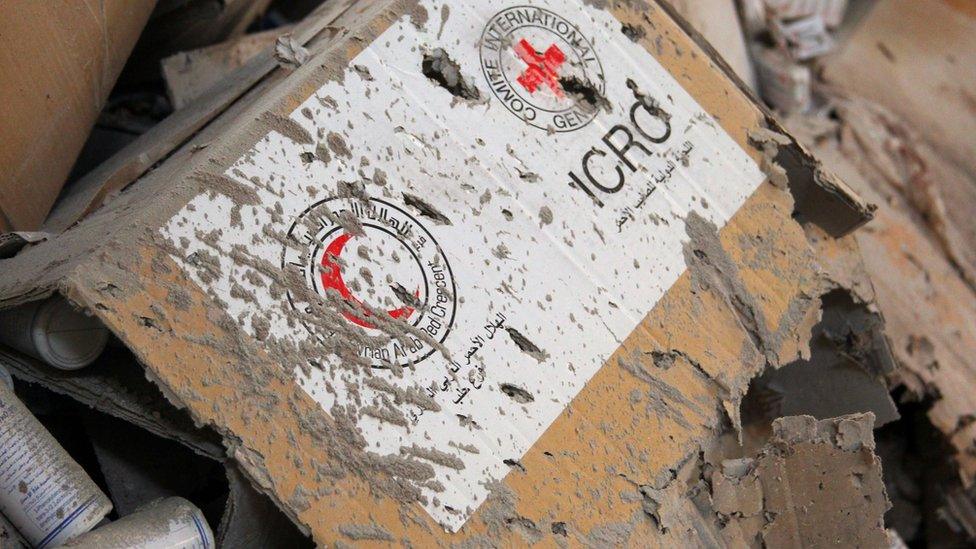
The UN has temporarily suspended aid deliveries across Syria
The UN's Emergency Relief Co-ordinator, Stephen O'Brien, has called, external for an immediate, impartial and independent investigation into the incident.
UN officials stressed that officials had "completely deconflicted" the aid delivery with all parties beforehand by obtaining necessary permits from the government and notifying combatants on the ground of the lorries' movements. The convoy was also clearly marked as humanitarian.
Aid worker Stephen Ryan says his organisation is in shock following the attack
"International humanitarian law and human rights law plainly set out the basic responsibilities of warring parties to ensure the necessary protection of all humanitarian organizations, including personnel, facilities and other relief assets," Mr O'Brien said.
"Let me be clear: if this callous attack is found to be a deliberate targeting of humanitarians, it would amount to a war crime."
The president of the International Committee of the Red Cross, Peter Maurer, described the attack as a "flagrant violation of international humanitarian law".
Correction 24 November 2016: A reference to photos and videos showing dead and injured people has been removed from this report.